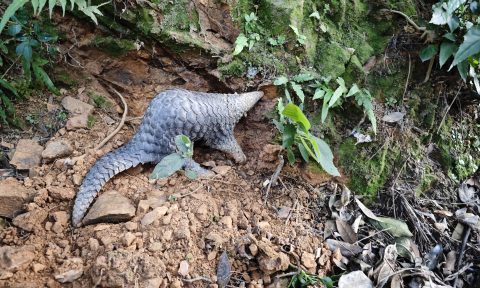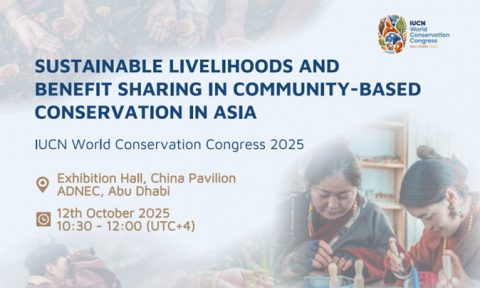Promote Business Nature-Positive Transition Through Green Finance and Nature-Related Disclosure | IUCN Congress 2025 Thematic Session
On October 10, 2025, the second day of the IUCN World Conservation Congress held at the Abu Dhabi National Exhibition Centre, a thematic session titled ” Promote business nature-positive transition through green finance and nature-related disclosure” concluded successfully. The session convened leading global experts in the fields of green finance, nature-related disclosures, and biodiversity conservation to engage in in-depth discussions on how innovative financial instruments and disclosure mechanisms can guide businesses towards more sustainable operating models.
 Group Photo of Session Speakers and Moderators
Group Photo of Session Speakers and Moderators
This thematic session was initiated and organized by the Shan Shui Conservation Center, in collaboration with: Africa Wildlife Foundation(AWF), All-China Environment Federation, Beijing Greenovation Institute for Public Welfare Development, Center for Nature and Society of Peking University, China Green Carbon Foundation, Huatai Securities, Huatai Foundation, International Institute of Green Finance(IIGF) of the Central University of Finance and Economics, IUCN Secretariat Asia Region, IUCN Headquarters Global Climate Change and Energy Transition Team, Microsoft, Mongolian Nature’s Legacy Foundation(MNLF), and Wildlife Conservation Society(WCS).
Highlights in Summary:
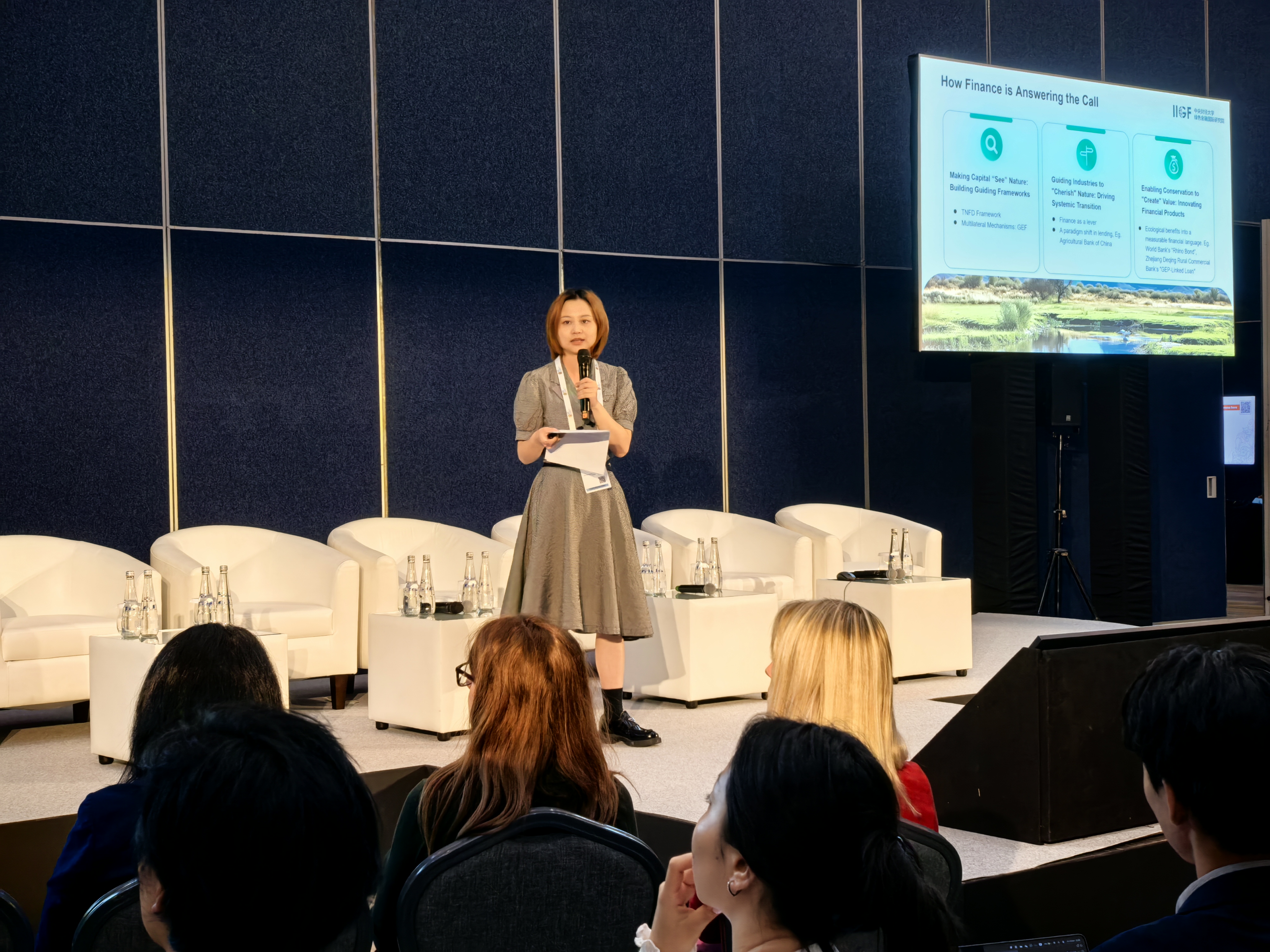
Zhou Zhou Discusses the Systemic Role of Finance in Supporting Biodiversity Conservation
Zhou Zhou, the researcher at IIGF of the Central University of Finance and Economics, presented detailed data and case studies illustrating the current global biodiversity financing gap and emphasizing the critical role of the financial sector in bridging this gap and driving systemic economic transformation. Currently, global annual investment in biodiversity ranges from $124 billion to $143 billion, while actual financial needs are estimated to be between $722 billion and $967 billion, representing a significant shortfall. Bridging this funding gap requires not only increased capital but also systemic economic transformation triggered through financial mechanisms. She noted that financial institutions are transitioning from passive observers to active participants, proactively responding to the goals of the Kunming-Montreal Global Biodiversity Framework by shifting investment patterns to support more biodiversity-friendly projects and businesses.

Cathrine Armour Introduces the TNFD Framework
Cathrine Armour, Director of TNFD Data Initiatives, provided a clear summary of the TNFD framework’s guiding principles and main components. The TNFD framework is built on seven foundational principles: market usability, science-based solutions, purpose-driven design, integration and adaptability, inclusivity across global sectors, alignment with climate-nature nexus goals, and a focus on nature-related risks. The TNFD recommends disclosure of 14 core global indicators, which are structured to provide a comprehensive overview of nature-related performance, and advocates the LEAP methodology, which stands for Locate, Evaluate, Assess, and Prepare. Referencing recent Australian regulations for mining companies, Armour highlighted that the government evaluates not just individual company impacts, but also the cumulative effects of all businesses within a region. This approach supports uniform decision-making and reinforces the need for mandatory benchmarking—such as disclosing carbon emissions and other impact metrics—so market transparency and comparability are improved. Armour acknowledged continued challenges in quantifying risks, which stem primarily from gaps and variations in underlying data quality and availability. She emphasized that integrating nature-related financial disclosures into mainstream investor and regulator decision-making is an evolving process, with momentum building but not yet fully mature. Future progress, she argued, relies not only on robust frameworks but also on sustained collaboration among scientific data providers, operational asset managers, financial industry professionals, and regulators. This cooperation is essential to ensure that risk indicators foster innovation while remaining grounded in reliable, actionable data.

Xu Jiayi Presents a Case Study Analysis of ASEAN Countries’ NBSAPs Driving Nature-Friendly Business Transformation
Xu Jiayi, Project Director from Beijing Greenovation Institute for Public Welfare Development, presented an in-depth analysis of the private sector components of the National Biodiversity Strategy and Action Plans (NBSAPs) of Southeast Asian countries, including Malaysia, Vietnam, Thailand, and Indonesia. She emphasized the importance of clear, specific, and actionable policy guidance in directing private sector engagement in biodiversity conservation. She pointed out that policy priorities vary across countries, necessitating tailored strategies based on each country’s specific priorities and strengths. Businesses need to focus on four key areas: supply chain sustainability, responsible land use management, strengthened environmental impact assessments, and improved spatial planning. The extent to which the private sector effectively adheres to these recommendations will directly impact their contribution to regional biodiversity conservation efforts.

Hugo Costa Shares WCS Biodiversity Offset Case Study in Mozambique
Hugo Costa, Director of Business & Biodiversity Impact at the Wildlife Conservation Society (WCS), presented the experience of how the WCS’s “Conservation, Mitigation and Biodiversity Offsets” (COMBO+) program implemented in Mozambique and other African and Asian countries as examples of how the adequate implementation of the mitigation hierarchy, including biodiversity offset mechanisms can achieve a balance between economic development and biodiversity conservation. The program works with Governments, private sector, academia and civil society to ensure No Net Loss and Net Gains at the project level, thus contributing to achieve nature-positive outcomes and meet national biodiversity targets. This is done through participating in policy and legislation, developing technical tools and guidelines, providing capacity building, and designing long-term implementation mechanisms.
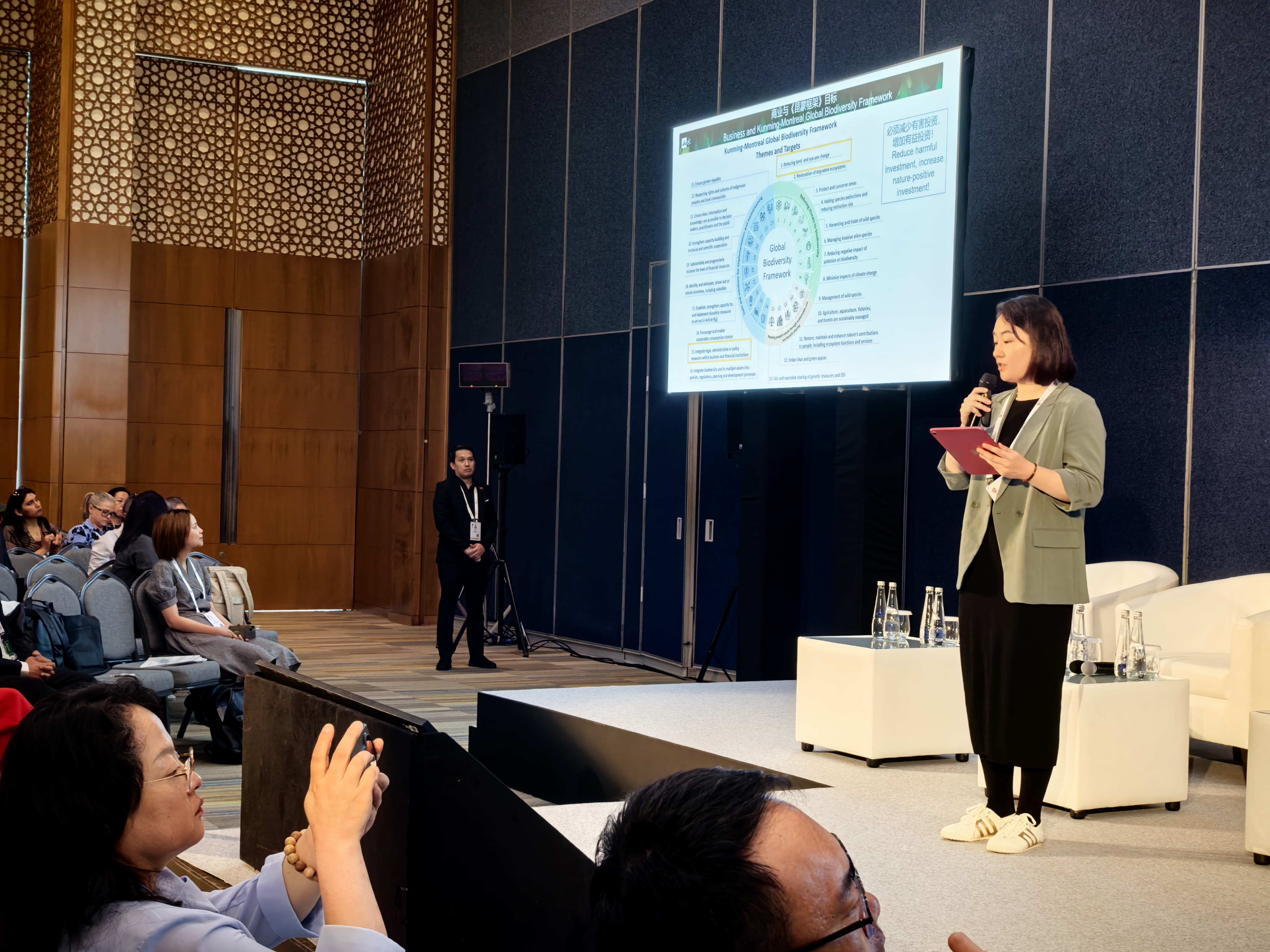 Cheng Chen Introduces Data Metrics for Financial Support of Nature-Friendly Enterprises and Guardrail Principles for Renewable Energy
Cheng Chen Introduces Data Metrics for Financial Support of Nature-Friendly Enterprises and Guardrail Principles for Renewable Energy
Cheng Chen, Program Director of the Nature Watch program of Shan Shui Conservation Center, emphasized how data enablement can integrate biodiversity considerations into investment decision-making processes, helping financial institutions identify and support companies with nature-related risks and opportunities. Shan Shui utilizes the “Nature Watch” database, Biodiversity Impact Assessment (BiA) tools, and the “Corporate Biodiversity Assessment System” to assist EIA institutions, companies, and financial institutions in identifying relevant risks and facilitating information disclosure. Using the potential impact of the renewable energy industry on biodiversity as an example, she referenced the “Renewable Energy Guardrail Principles” report released at the 5th World Congress on Biosphere Reserves (WCBR) parallel forum in September, advocating for stricter industry baseline and integrating nature-positive concepts throughout the entire lifecycle of wind and solar power development, while respecting and protecting the rights of local communities.

Fishbowl Discussion
In the subsequent Fishbowl interactive session, representatives from multilateral development banks, foundations, and NGOs engaged in discussions moderated by Liu Qiulin, Programme Coordinator Officer at the IUCN Headquarters Global Climate Change and Energy Transition Team, focusing on green finance screening criteria, cross-regional cooperation models, private sector engagement pathways, and existing challenges and barriers.
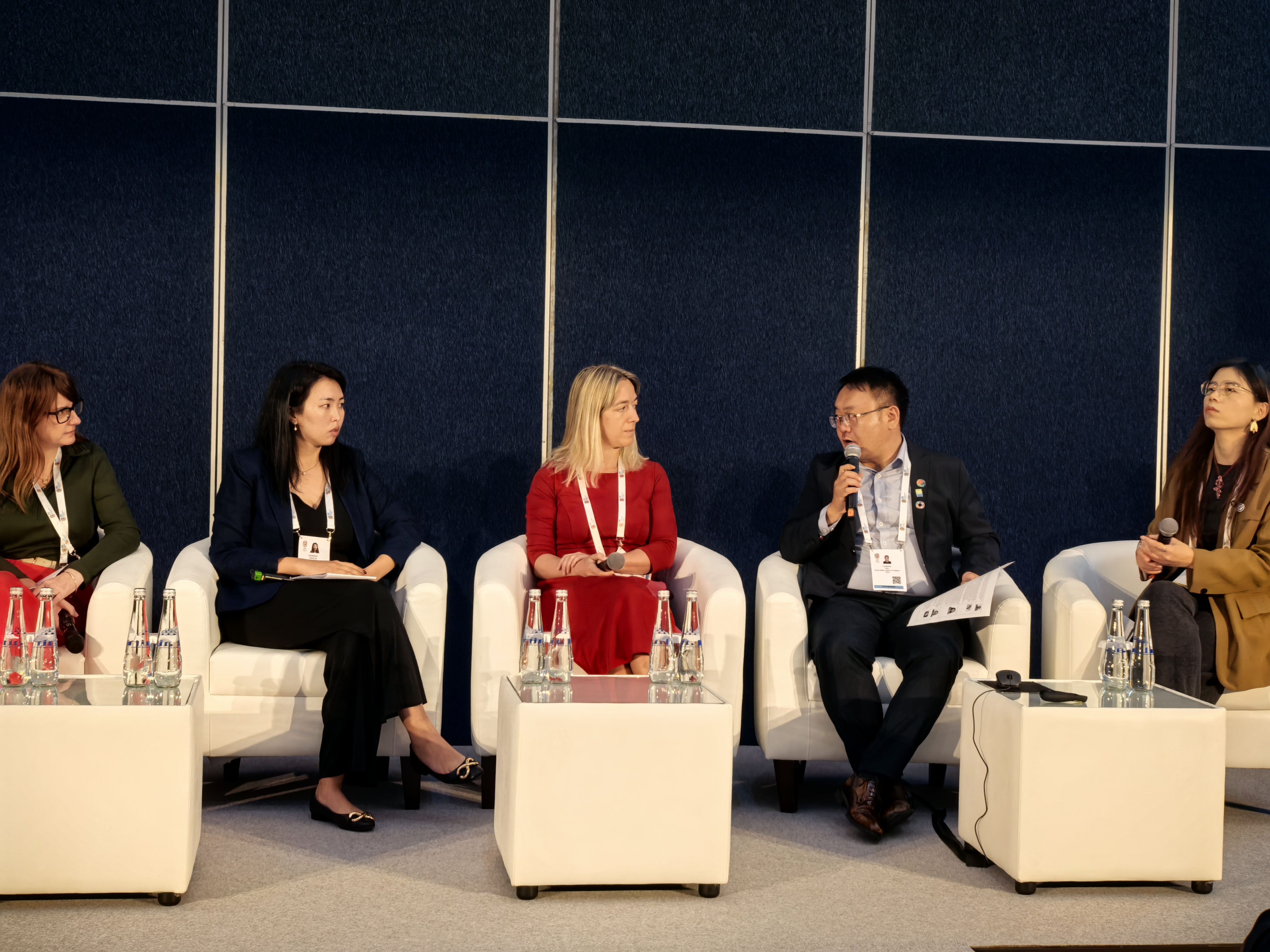
Hou Yuanqing Shares Experiences in Supporting Forest Carbon Projects and Promoting Financial Institution Involvement in Conservation Projects
HOU Yuanqing, Deputy Secretary-General&Project Management Center Director, China Green Carbon Foundation, shared the foundation’s experience in supporting forest carbon sink projects, species and habitat conservation. In the early stages, many projects were supported through charitable donations for project design, implementation, and monitoring. Now, efforts are more focused on exploring private sector involvement, especially in partnering with policy banks, development banks, and commercial banks to identify opportunities and promote sustainable project development. In practice, the biggest challenge often lies in bridging the cognitive gap between investors and conservationists. Inviting investor staff to conduct on-site inspections can help them better understand ecosystems, forests, and biodiversity conservation efforts, enabling them to make informed investment decisions.

Nomindari Enkhtur Presents Mongolia’s Progress in Green Finance
Nomindari Enkhtur, CEO of the Mongolian Nature’s Legacy Foundation (MNLF), presented Mongolia’s progress in green finance, including the establishment of a green taxonomy and a coalition of nature-positive financial institutions, as well as the practice of supporting steppe ecosystem restoration through innovative financial products such as green loans. Mongolia is the second country in the world to adopt a green taxonomy, including a separate chapter to clearly define biodiversity conservation, aimed at guiding private sector investment in biodiversity conservation-related projects. MNLF is also designing green financial products to address the issue of Mongolian grassland degradation by linking funding with sustainable husbandry practices. Through cooperation with commercial financial institutions, MNLF aims to develop green loans for herders at preferential interest rates, but the precondition is that herders must participate, commit to implementing sustainable pasture management practices, and achieve specific ecological conservation targets.

Rachael Barza Shares Experience in Investing Green Finance Projects
Rachael Barza, Lead of Climate Adaptation and Natural Finance at the European Bank for Reconstruction and Development (EBRD), shared the EBRD’s experience in green project investment, emphasizing the adoption of blended finance models and focusing on the impact of projects beyond site boundaries. For example, when cooperating with wind power developers, the EBRD focuses not only on the assessment of the project itself but also on the impact on the broader geographical landscape and on coordination with other initiatives to achieve greater comprehensive benefits. In addition, to fully realize the potential of green finance, one must first reduce expectations of “perfection.” There is a current trend where people often refuse to participate because a project is not perfect or ambitious enough. This leads to the shelving of many beneficial projects that could be implemented. True progress lies in taking pragmatic action, addressing the most pressing issues of the moment, and continuously improving in practice. She emphasized that in the pursuit of excellence, “good enough” solutions should not be overlooked.
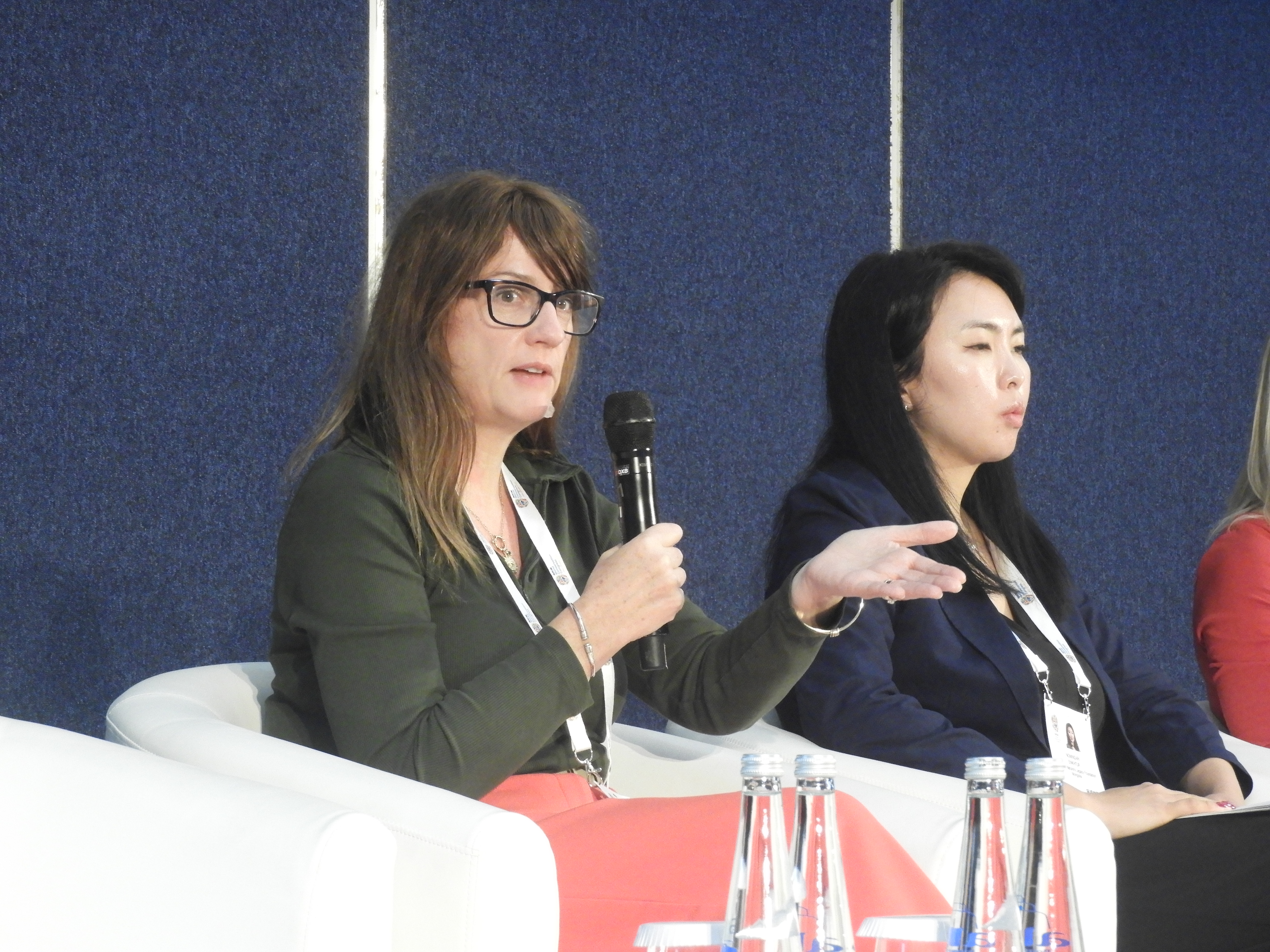
Lesley Dickie Shares the “Regional Flyway Initiative” Project of South Dongting Lake, China
Lesley Dickie, Executive Vice President of BirdLife International, emphasized the need for strengthening cross-border cooperation and multi-stakeholder coordination at the regional level for the protection of migratory bird flyways involving multiple countries and regions. The first project along the East Asian-Australasian Flyway is an exemplary case—Dongting Lake in China, the second largest freshwater lake in China, is not only a vital habitat for birds but also holds immense agricultural and fisheries value. The project has now been launched, with BirdLife International not only cooperating with development banks but also mobilizing local governments, social organizations, communities, and other parties to jointly participate, find common ground for all parties, and promote sustainable eco-friendly fisheries and agricultural practices.
In summary, this thematic session provided participants with a valuable platform for exchange. Through the presentations and discussions of the speakers, attendees gained a deeper understanding of the role that finance plays in driving the transformation towards nature-positive outcomes. This roundtable successfully explored the impact, obstacles, and future solutions of finance for a nature-positive economy. To fully harness the power of finance, it is essential to continue strengthening international cooperation, embrace innovation, develop clear policies, and prioritize the rights and well-being of indigenous peoples and local communities.

